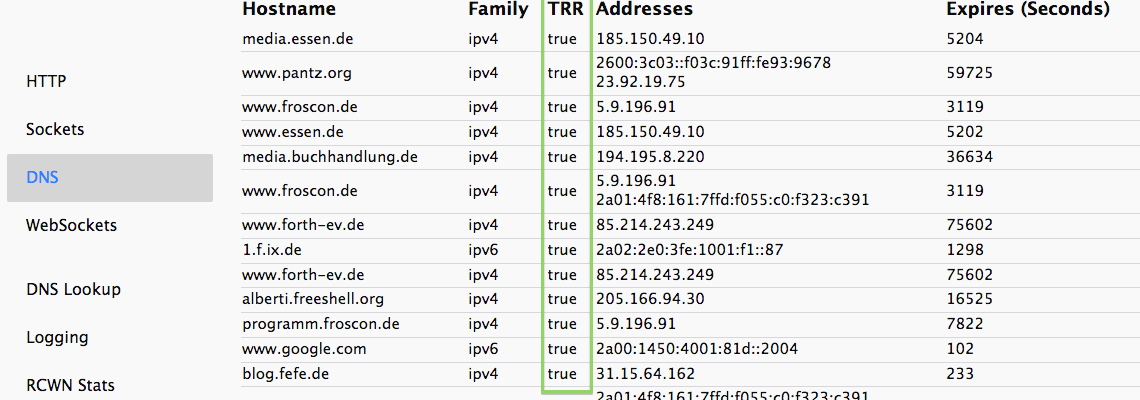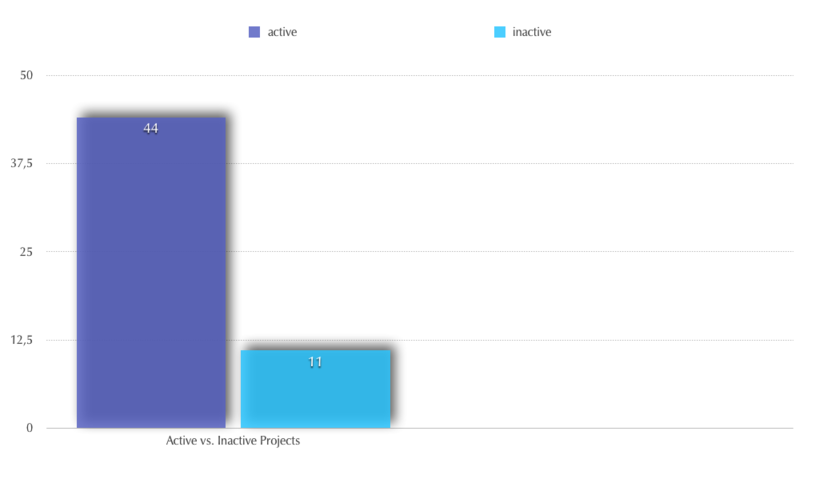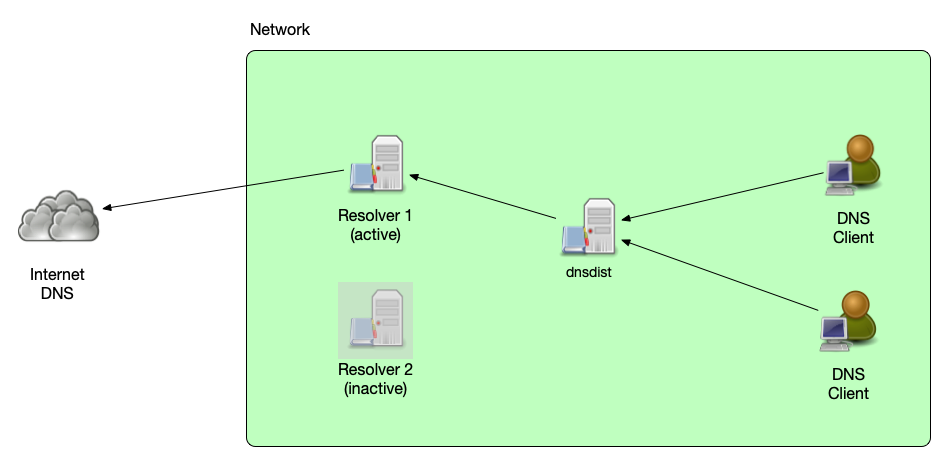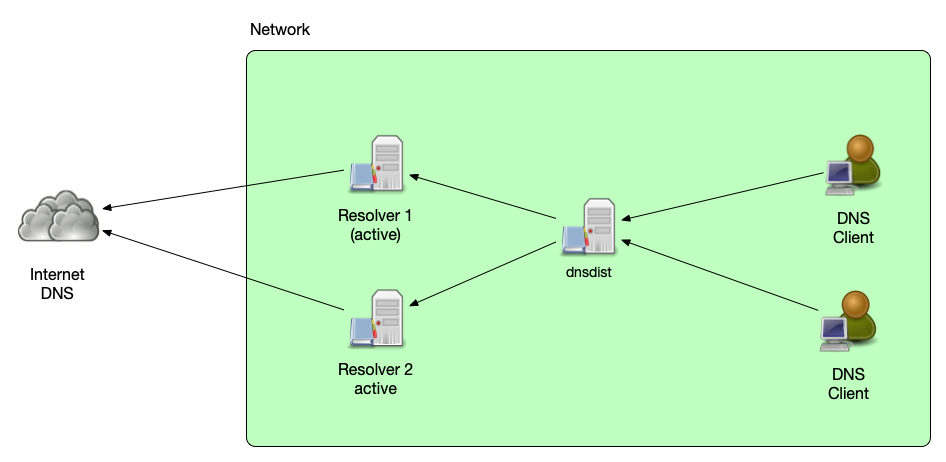DoH, or Don't?
Carsten Strotmann, sys4.de
2022-02-25 Fri 00:00
Created: 2022-02-25 Fri 08:29
Agenda
- DNS-Privacy
- DoH/DoT/DoQ
- The Dilemma
- Summary
Privacy in DNS?
- in recent years, the IETF has expanded the DNS protocol with
privacy features
- DNS-over-TLS (transport encryption between DNS client and DNS resolver)
- DNS-over-HTTPS (transport encryption between DNS client and DNS resolver)
- QNAME Minimization (less metadata in DNS)
- EDNS-Padding (hiding of DNS data in encrypted connections)
The need for more DNS privacy
- a study presented at IETF 105 during the Applied Networking Research
Workshop in July 2019 found that
- 8.5 % of networks (AS) intercept DNS queries (27.9% in China)
- (today) most queries are answered un-altered
- but the situation might change, intercept server might change DNS answers
encrypted transport for DNS
- Terminology
Do53= DNS-over-Port53 - classic DNS (UDP/TCP port 53)DoT= DNS-over-TLS - TLS as the transport for DNSDoH= DNS-over-HTTPS - HTTPS as the transport for DNSDoQ= DNS-over-QUIC - QUIC as the transport for DNSDoC= DNS-over-Cloud - DNS resolution via cloud services (Google, Q9, Cloudflare …)
Performance of DoT/DoH (1/2)
- with TLS 1.3 performance of DoT/DoH is quite good
- with established connections, performance can be similar to DNS-over-UDP due to
- Pipelining
- TCP fast open
- 0-RTT resume
- on connections with packet loss, DoT/DoH can be faster and more reliable than Do53!
- not all implementations are fully optimized
Performance of DoT/DoH (2/2)
- Mozilla found that in lossy networks DoH can be faster and more reliable than Do53
- The study "Analyzing the Costs (and Benefits) of DNS, DoT, and DoH for the Modern Web" presented at Applied Networking Research Workshop July 2019 confirms that finding
DoT - DNS-over-TLS
- RFC 7858 "Specification for DNS over Transport Layer Security (TLS)"
- DNS wireformat over TLS over TCP
- Port 853 (TCP)
- Encryption and Authentication (Internet PKI or via DANE)
DNS-over-TLS (1/3)

DNS-over-TLS (2/3)

DNS-over-TLS (3/3)

DNS-over-TLS modes
- DNS-over-TLS can be operated in two modes
- opportunistic - try TLS authentication, but still use server in case authentication fails
- strict - only use server if there are no errors in the TLS connection
DNS-over-TLS operators
DoH - DNS over HTTP(S)
- RFC 8484 DNS Queries over HTTPS (DoH) (P. Hoffman, ICANN and P. McManus, Mozilla) https://tools.ietf.org/html/rfc8484
- DNS HTTP-Format over HTTPS over TCP, Port 443 (HTTP/2)
- URL: https://server/dns-query{?dns}
- Encryption, Authentication and Cloaking
DoH - DNS-over-HTTPS

DoH timeline
- IETF 100 - November 2017 - DNS over HTTP(S) (DoH) workinggroup started: https://datatracker.ietf.org/wg/doh/about/
- IETF 101 - March 2018 - work on DNS Queries over HTTPS finished, start of working group last call (WGLC) in April 2018
- October 2018 - RFC 8484 published
DNS-over-HTTPS and IDS/Network-filter
Quote from RFC 8484:
Operational Considerations […] Filtering or inspection systems that rely on unsecured transport of DNS will not function in a DNS over HTTPS environment due to the confidentiality and integrity protection provided by TLS.
DoH in Firefox (1/3)
- Firefox 61+ (manual switch)
- Firefox TRR Konfigurations Optionen

DoH in Firefox (2/3)
- Firefox Quantum (Screenshot FF 68)

DoH in Firefox (3/3)
- Mozilla plans to enable DoH in Firefox by default in the future. No date announced.
- User can select among a list of certified DoH operators per "region"
- operators of DoH services can apply for privacy certification
- Mozilla Policy Requirements for DNS over HTTPs Partners: https://wiki.mozilla.org/Security/DOH-resolver-policy
DoH in Google Chrome
- currently, DoH can be enabled in Chrome via commandline switches https://judge.sh/how-to-enable-dns-over-https-on-chrome-right-now/
- a GUI configuration is coming with Chrome Version 78
- Google has no plans to enable DoH by default
DoH operators (Selection)
- Cloudflare https://cloudflare-dns.com/dns-query
- Cloudflare/Mozilla https://mozilla.cloudflare-dns.com/dns-query
- Clean Browsing https://doh.cleanbrowsing.org/doh/family-filter/
- PowerDNS https://doh.powerdns.org
- BlahDNS (de) https://doh.de.blahdns.com/dns-query
- SecureDNS https://doh.securedns.eu/dns-query
Current DoT/DoH status
Firefox Browser
- Firefox Trusted Recursive/Remote Resolver (TRR) Program
- Cloudflare (default) or NextDNS
- Comcast XFinity (coming)
- automatic roll-out started in February 2020
Chrome(ium) Browser
- DoH is implemented and can be enabled by the user
- Google Chrome
- Opera
- Vivaldi
- Brave
- Microsoft Edge
- Bromite
- DoH "auto upgrade" for the configured DNS resolver (manual configured or DHCP/RA supplied)
- Google is experimenting with adaptive DoH-Resolver-Discovery via DNS
Safari Browser (iOS, iPadOS, MacOS)
- support for DoH and DoT in iOS 14 and MacOS 11 'Big Sur'
- Support for Adaptive DNS resolver discovery and oblivious DNS (oDoH)
Android
- DoT available from Android 9 "Pie"
- manual setting
- "auto upgrade" from the configured DNS resolver, or Google DNS as fallback
Apple MacOS 11 and iOS/iPadOS 14
- support for DoT and DoH
- global and per App/Application resolver selection possible
- "encrypted DNS" configuration Apps possible, user can choose provider by installing App
- OS can learn "per Domain" DoH/DoT setting via DNS or HTTP (Adaptive DNS-over-HTTPS)
- OS can discover DoH/DoT Server via DHCP/PvD (Provisioning Domains)
or queries to
resolver.arpavia classic DNS53 - Discovery methods in active discussion in the IETF ADD working group
Microsoft Windows 10
- support in latest Windows 10/11 builds
Linux
- DoT support in
systemd-resolvedfor some time - opportunistic mode only (automatic fallback to DNS53)
- no server authentication (MITM possible)
- global or "per interface" setting
- not enabled by default
OpenBSD
- DoT support in
unwind - not enabled by default
- opportunistic "auto update" mode or manual configured "strict" mode
- server authentication via TLS certificate
DoT vs DoH
- differences between DoT and DoH
- DoT can be easily blocked, because it is running on an dedicated port (853)
- DoH is made to look like normal HTTPS traffic, selective blocking of DoH is difficult
- DoH seems to be easier to implement, because of existing HTTPS library functions in programming languages
- DoH enables developers to do DNS name resolution on an application level, which some people think is bad
The DoH dilemma
- to reach the Internet users that are in need of privacy, DoH needs
to be enabled by default
- DoH Server selection can be seen as similar to the CA selections browsers do
- a fixed selection "per region" will (still) lead to centralization
of all DNS queries with a few DNS operators
- but that might still be the case even without DoH, some countries in Asia send > 90% of DNS queries to DoC (Google)
DoH and DoT Software - only browser?
- new DNS privacy protocols sparked a large number of new software projects
- this part of the presentation will look at
- comparison of the start of new software projects in comparison to the new standards
- number of projects for DNS-over-HTTPS vs. DNS-over-TLS
- programming languages used to implement the new protocols
The survey
- looked at 55 DoT/DoH open source software projects on Github and Gitlab
- done in May 2019 and June 2019
- only software products, no composition projects (Docker Container etc)
- full list: https://doh.defaultroutes.de/implementations.html
- see presentation at RIPE 78 and recent blog post in the APNIC blog (linked from the page above)
Languages

DoT vs DoH
Which protocols are implemented. Some projects implement both:

Project start
Year of the first commit, frist release or when DoH/DoT functions were implemented

Freshness
Activity in the project in the last 6 month?

Applications
- Firefox
- Chrome
- curl
- Tenta-Browser
- Bromite
System Resolver
- systemd-resolved
- unwind
- resolver module for Linux glibc
Client-Proxies
- sdns
- dnscrypt-proxy2
- veild
- stubby
- unbound
- cloudflared
- Dohnut
- dns-over-https
Server-Proxies
- rust-doh
- dnsdist
- dns-over-https
Server
- BIND 9.18
- unbound
- Knot
- sdns
Whats missing in DoH/DoT software
- certificate authentication via DANE
- Wittness function - query multiple provider and compare response data
- security audits of DoH/DoT software
DNS over QUIC - the future of DNS?
- DNS over QUIC over UDP
- Specification of DNS over Dedicated QUIC Connections https://datatracker.ietf.org/doc/html/draft-ietf-dprive-dnsoquic
what is QUIC
- modern TCP replacement from Google, being currently standardized in the IETF
- based on UDP, implements TCP features
- implemented as part of the application, not the OS
- includes TLS 1.3
- 0-RTT
- DoQ similar to Do53 (DNS-over-UDP)
- QUIC IETF WG documents https://tools.ietf.org/wg/quic/
DNS over QUIC

DNS over QUIC Comparision
Was ist dnsdist
- dnsdist ist ein Open-Source DNS load-balancer
- Homepage: https://dnsdist.org
- Lizenz: GPL Version 2
- dnsdist wird von PowerDNS.COM B.V erstellt und betreut
- dnsdist ist unabhängig vom PowerDNS autoritativen DNS server und vom PowerDNS Recursor (die Produkte teilen sich Quellcode)
- dnsdist kann zusammen mit anderen DNS Servern benutzt werden (BIND 9, NSD, Windows DNS, Unbound …)
dnsdist Besonderheiten (1)
- dnsdist empfängt DNS Anfragen und leitet diese an nachfolgende
DNS Resolver oder autoritative DNS Server weiter
- fail-over oder load-balancing Regeln steuern diese Weiterleitung
- Antworten können im dnsdist gecached werden
- dnsdist kann Angriffe und DNS-Missbrauch erkennen und abwehren
- DNS-over-TLS und DNS-over-HTTPS Unterstützung
- DNScrypt Unterstützung
dnsdist Besonderheiten (2)
- eBPF Socket Filter (Linux)
- Einfache aber mächtige Konfigurations-Möglichkeiten mit der Programmiersprache Lua
- Kann im Betrieb dynamisch umkonfiguriert werden (ohne Neustart)
- Remote HTTP API
- Eingebauter Web-Server für API-Zugriffe, Monitoring und Statistiken
Anwendungsszenarien für dnsdist
Fail-Over
- dnsdist kann DNS Anfragen basierend auf der Verfügbarkeit von
Backend-Servern im Pool verteilen
- Hierzu wird die Policy
firstAvailablebenutzt - Bei dieser Policy haben die Server im Pool eine Reihenfolge: der erste verfügbare Server in der Reihenfolge bekommt alle Anfragen
- Diese Policy kann zusätzlich mit einem "Anfragen pro Sekunde" Limit konfiguriert werden
- Wird dieses Limit überschritten, so werden die überzähligen Anfragen an den nächsten DNS Server in der Reihe geleitet
- Hierzu wird die Policy
Fail-Over

Load-Balancing
- dnsdist kann DNS Anfragen auf verschiedene Back-End-Server (oder Back-End-Server Pools) verteilen. Hierbei gibt es verschiedene Load-Balancing Konfigurationen:
leastOutstanding: benutze den/die Server mit den wenigsten noch ausstehenden Anfragenchashed: verteile die DNS Anfragen basierend auf dem Hash des Domain-Namens der Anfragewhashed: verteile die DNS Anfragen basierend auf dem Hash des Domain-Namens der Anfrage, aber mit einer Gewichtung der Back-End-Serverwrandom: zufällige Verteilung der Anfragen, jedoch mit einer Gewichtung der Back-End-Server (die Back-End-Server bekommen einen Anteil der Anfragen basierend auf der Gewichtung)roundrobin: Anfragen werden auf Basis eines Round-Robin Algorithmus verteilt
Load-Balancing
- Die Load-Balancing Regeln können durch eigene, in der Programmiersprache Lua
(https://www.lua.org/) programmierten, Regeln erweitert werden
- Beispiel einer einfachen Round-Robin Policy:
counter=0
function luaroundrobin(servers, dq)
counter=counter+1
return servers[1+(counter % #servers)]
end
setServerPolicyLua("luaroundrobin", luaroundrobin)
Load-Balancing

DoH/DoT Proxy, DDoS und Malware Absicherung
- dnsdist kann neue Funktionen zu bestehenden autoritativen DNS
Server und DNS Resolvern hinzufügen, ohne das Änderungen an diesen
Backend-Servern notwendig sind
- Schutz vor Denial-of-Service Angriffen
- Filtern von bekannten Malware-Domains (aka DNS-Firewall)
- DNS Transport-Verschlüsselung (DNS-over-TLS und DNS-over-HTTPS)
DoH/DoT Transport Verschlüsselung

Messdaten in einem DNS-Server-Cluster zusammenführen
- Da dnsdist als zentrales System die Anfragen an die Server eines DNS-Clusters weiterleitet, kann dnsdist ein Monitoring für einen DNS-Cluster bereitstellen
- für mehrere DNS Resolver
- für mehrere autoritative DNS Server
Messdaten zusammenführen

Zentraler DNS Cache
- dnsdist ist kein DNS-Resolver, es kann keine DNS-Delegationen
verfolgen und DNS Namen selbstständig auflösen
- dnsdist kann jedoch die Antworten von DNS-Resolvern im Cache speichern und von dort beantworten
- dnsdist kann optional abgelaufene DNS-Informationen senden (TTL expired), wenn keiner der konfigurierten Back-End-Server erreichbar ist
> getPool(""):getCache():printStats()
Entries: 122/10000
Hits: 9147
Misses: 10147
Deferred inserts: 1
Deferred lookups: 0
Lookup Collisions: 0
Insert Collisions: 0
TTL Too Shorts: 0
Zentraler DNS Cache

Schutz von autoritativen DNS Servern
- dnsdist kann als front-end Load-Balancer vor autoritativen DNS
Servern eingesetzt werden
- Mittels spezieller Regeln kann dnsdist die autoritativen DNS Server vor bestimmen bösartigen DNS Anfragen schützen
- Back-End Server können aus dem Cluster genommen werden (für Wartung oder zur Analyse von Vorfällen), ohne das der DNS-Dienst beeinträchtigt wird
Schutz von autoritativen DNS Servern

Schutz von autoritativen DNS Servern

DoH/DoT Termination
- dnsdist kann DNS-over-TLS (DoT) und
DNS-over-HTTPS (DoH) Verbindungen terminieren
- dnsdist erstellt einen DoH/DoT "proxy", welcher DoH/DoT Anfragen von DNS Clients annimmt und via klassischem DNS (UDP/TCP Port 53) an einen Back-End-Resolver weiterleitet
DoH/DoT Proxy

Motivation für einen DoH/DoT Proxy?
- Einfache Installation
- Die existierenden DNS-Resolver müssen nicht geändert werden
- Über separate Hardware/Server lässt sich diese Lösung einfach skalieren
Questions?
Links 1
- Passive DNS Replication https://www.first.org/conference/2005/papers/florian-weimer-paper-1.pdf
- RFC 7858 "Specification for DNS over Transport Layer Security (TLS) https://tools.ietf.org/html/rfc7858
- DNS-over-TLS in Android 9
Links 2
- DNS-over-TLS implementations https://doh.defaultroutes.de/implementations.html
- DNS-over-TLS operator (selection)
- Cloudflare/APNIC https://developers.cloudflare.com/1.1.1.1/dns-over-tls/
- Quad9 Resolver https://www.quad9.net/
- SurfNET https://dnsprivacy.org/wiki/display/DP/DNS+Privacy+Test+Servers
- Verisign https://dnsprivacy.org/wiki/display/DP/DNS+Privacy+Test+Servers
Links 3
- DNS over HTTPS
- DNS-over-HTTPS RFC 8484 https://tools.ietf.org/html/rfc8484
- Google DNS-over-HTTPS Dienst https://developers.google.com/speed/public-dns/docs/dns-over-https
- OpenResolve https://www.openresolve.com/
- DinGO https://github.com/pforemski/dingo
- CoreDNS https://coredns.io/2016/11/26/dns-over-https/
Links 4
- DNS-over-QUIC
- IETF Draft https://tools.ietf.org/html/draft-huitema-quic-dnsoquic
- QUIC Documents https://tools.ietf.org/wg/quic/
- Is the DNS evolving to fast?
- “The DNS Camel”, or, the rise in DNS complexity https://blog.powerdns.com/2018/03/22/the-dns-camel-or-the-rise-in-dns-complexit/
- RFC 8324 - DNS Privacy, … Time for Another Look? https://tools.ietf.org/html/rfc8324
Links 5
- July 2019 ANRW Workshop (Videos and Proceedings) https://irtf.org/anrw/2019/program.html
- Who Is Answering My Queries:Understanding and Characterizing Interception of the DNS Resolution Path http://delivery.acm.org/10.1145/3350000/3341122/p15-liu.pdf
- Analyzing the Costs (and Benefits) of DNS, DoT, and DoH for the Modern Web https://irtf.org/anrw/2019/program.html
